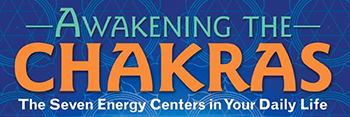WHAT AWAKENING THE CHAKRAS IS NOT:
It’s not a Hatha Yoga instruction book with photos or diagrams of asanas. Many shelves filled with good books already do that. So do plenty of websites. And you may even be taking a Hatha Yoga class in which your instructor shows you the asanas he or she wants you to do, demonstrates them, and has you do them together in a group –or individually. This book adds other very different dimensions that complement Hatha Yoga instruction.
JUST ONE HATHA YOGA TIP
We’d like to point out just one important item that many but not all instructors emphasize. That’s to sunchronize your movements with your breathing. The most basic form of this is inhaling during one half of a posture’s sequence of movement and exhaling during the other half, with a slow meditative consciousness throughout. Moment by moment, notice whatever you experience in you body, your emotions, and your mind. As you do, your yoga becomes also a meditation. You want to listen to your body and regulate your somatic processes so far as you can as you do your practice.
SOME ITEMS THAT YOU WON’T FIND IN THE BOOK OR ELSEWHERE ON THIS WEBSITE
You might wish to have a broader background for your yoga pactice and chakra studies. A number of different paths of self development are called yogas. “Yoga” means “union.” Union of the mind and body. Union of the personal self with the world and universe. Union with God. Union with the knowledge of the ages. You can find information about all this by combing the web, but that’s quite an undertaking. You might find it useful to begin with a 24-page moderately detailed description of Yogic ideas and practice. There’s a link to it at the end of this post. (It’s a copy of lecture notes for a presentation Victor gave his students at the university.) For openers here are a few highlights.
THE PRINCIPAL YOGAS ARE:
1. Hatha Yoga. You know what this is.
2. Raja Yoga (“the royal yoga”) is meant to focus and discipline the mind. Sometimes it is used as a a synonym for meditation.
3. Bhakti Yoga is the yoga of love and devotion. It includes identification with your spiritual teacher and cultivating loving kindness in your heart. It also includes practices meant to produce a state of ecstatic bliss (chanting, dancing, etc.) A goal of Bhakti Yoga in India is to see the divine in everyone and everything,
4. Karma Yoga is the yoga of action, charitable acts, selfless service or seva. It is dedication to the well-being of other people and beings on the basis of your own self-development.. Its attitude is one of fundamental equality with the person you are helping — not self-righteous self-congratulation about the good you are doing as you sneer at others who are doing less.
5. Jnana yoga is the yoga of knowledge and wisdom, trying to discover truth through reason, the intellect, and accumulated experience passed down through the years and ages.
6. Tantra Yoga, also called Kundalini Yoga, is influenced by Tibetan thought and is connected with worship of the divine as the Supreme Mother in any form she may assume. Its “left handed” and “right handed” paths are described in Awakening the Chakras.
7. Purna or Integral yoga is Sri Aurobindo’s 20th Century synthesis of India’s traditional yoga systems. It holds that active participation in life is needed to complement mental serenity and self-purification. The poet Tagore stresses finding freedom amid the interactions of relationships and society.
Not included among the seven yogas above, but considered one of the foundations of classical yoga philosophy, is the collection of YAMAS and NIYAMAS passed down fom the 2nd century BCE teacher Patanjali. His YOGA SUTRAS are the most complete systematization of India’s spiritual literature and India’s central guide to ethics. (In the gold-colored illustration at the top left of each page of this website, you can see Patanjali seated on the coils of a cobra with the OM symbol behind him.)
LEARN MORE about all seven yogas, the history of yoga, and central themes in yogic philosophy and psychology in this pdf link.
(To read “Learn More” online, Chrome & Safari work fine. Firefox do not open it for online reading but will download it and you can read the download.)

